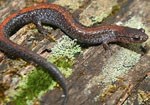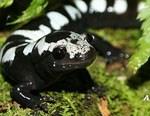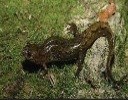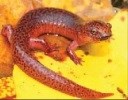|
Prince William Forest Park has wonderful salamander habitat. Two major streams run through the park, providing the moisture that is so vital to their survival. The mature deciduous trees produce a deep layer of detritus, or dead decomposing plant matter, that shelters the salamanders from the drying sun and wind. The life span of salamanders can vary greatly, but they have been known to live up to 20 years in captivity. Some of the representative species we have in the park will be discussed here. 
Andrew Hoffman Eastern Red-Backed Salamander, Plethodon cinereusThe most common salamander in our area is the eastern red-backed. Although many in number, this species is unique for several reasons. First of all, this species is totally lacking lungs, breathing through its moist skin for respiration. In addition, it occurs in two different color forms. The 'redbacks' are grey with either a red or yellowish stripe down the back, and the 'leadbacks' are a solid dark grey with no striping. Lastly, red-backs hatch from the egg as adults, skipping the juvenile stage entirely. 
Andrew Hoffman Eastern red-spotted newt, Notophthalmus viridescensAfter a 'gully washer' rain storm, you may be lucky enough to see many newts crossing the trails. Depending on the age, some will be at the terrestrial stage, called 'red efts.' Older newts are aquatic and an olive green color with red spots, but will get washed up on land after a hard rain. The adults are fun to catch with a dip net, but must always be returned to their habitat unharmed. Eastern red-spotted newts are toxic to predators but harmless to humans. The red color of the young serves as a warning and help protect them from predation. 
Marbled Salamander, Ambystoma opacumMarbled salamanders are a sight to behold in the Piedmont forest. They are rather stocky but can reach almost 5 inches in length. Their moist skin is black with the females having silvery bands all down their body, while the male's bands look more whitish. Their aquatic larvae are easily seen because they are the only ones active in the icy cold of winter. 
Northern Dusky, Desmognathus fuscusDuskies are a rather non-descript light brown with worm-like markings, and faint blotchy stripes on their sides. They can reach 2.5-4.5”, and may be the most common salamander in the US. They are strongly terrestrial but are never far from running water. 
Spotted, Ambystoma maculatumA large salamander reaching 4.5-7.5” They are solid gray to blue with large yellow spots, but the clear belly with no markings is also a great identifying characteristic. They breed in late winter and are distributed throughout most of Virginia. Their larvae is aquatic and they can eat larger prey items, including other salamanders. 
White-spotted slimy, Plethodon cylindraceusThe common name aptly describes these salamanders, with a base color of dark black with scattered white spots. They possess a robust rounded tail, and can reach 4.5-6”. They secrete a slime that is very hard to remove from hands and does well at warding off predators. The eggs are laid on land in moist dark areas in the summertime, and young hatch as juveniles, skipping the larval stage entirely. They have an advantage in that they can survive in both aquatic and terrestrial habitats, depending on what is available. 
Two-lined, Eurycea sp.Both the northern and southern varieties of this salamander can occur in the park. Indistinguishable by sight, for our purposes we won’t worry about differentiating them. The two-lined is 2.5-4.5” in length, and is yellow-orange with dark stripes down the back and sides, belly is yellow as well. Eggs are laid under rocks in the water, hatching into an aquatic larvae lasting 1-3 years. 
Eastern mud, Pseudotriton montanus sp.Adults reach 3-6” and are stocky with a muddy red background color with darker red on their back. Juveniles are brighter red, but very similar, both having black spots. Eggs are laid every other year, hatching into aquatic larvae around February. 
Northern red, Pseudotriton ruber ruberNorthern reds are about 4-6” long. They are red-orange salamanders with small black dots, but have no flecks around the snout. They have a yellow iris and a clear unmarked belly. Their coloration seems to mimic the toxic red eft, however they are not toxic. They can be found near cold streams, but further away from water than some other salamanders. The aquatic young hatch in winter, and become terrestrial adults in 2 ½ years. 
NPS photo Four-toed, Hemidactylium scutatumFour-toed salamanders are 2-3.5” long. They are gray above with distinctive white belly with dark spots. They lay eggs in late winter in moist spagnum moss as this is a requirement within their habitat. They have an aquatic larval stage that drop into water when they hatch. The adults are terrestrial and are usually found under leaf litter. As their name implies, there are only four toes on the hind feet instead of the more typical five toes. What's In a Name?The word “salamander” translates from greek meaning “fire lizard”. The origin of this name probably goes back to the observation of a salamander emerging from a fire after a fresh log was thrown in. They sleep in such places and are forcibly evicted by the flames. However, it was mistakenly believed that since this animal crawled from the fire that it was born of fire, or perhaps fire resistant. It’s a rather ironic title for an animal that isn’t a lizard at all, but an amphibian who must stay cool and moist in order to survive. Hence the name “fire lizard” was originated, and still persists today. An Indicator SpeciesSalamanders are amphibians, living part of their lives on land and part in water. Worldwide there are over 400 different species. You will only find them in moist habitats because they need to keep their skin wet to survive. Many of them also lay their eggs in water, having a larval stage that looks more like a tadpole than a baby salamander. The diversity and fragility of these creatures makes them a challenge to study. Salamanders are an indicator species. A decrease in their numbers often indicate to scientists a decrease in watershed health. This can be caused by ‘point-source’ pollution such as a drainage pipe or leaky oil pan from a car; or ‘non-point source’ pollution such as acid rain. Prince William Forest Park protects about 50% of the Quantico Creek watershed and is often looked at as a high water quality area. Identity CrisisThe terrestrial salamanders generally have rounded tails, and aquatic salamanders have a more laterally compressed tail that acts as a ruder and for propulsion. As with most wildlife, when looking to identify a species there are certain characteristics one must observe for the sake of accuracy. Variety AboundsYou will see the term “migration” occur frequently in salamander field guides. This refers to the movements that occur to the breeding ponds. There is a lot of variation in salamanders that isn’t present with other groups of animals. Most lay eggs in water, but some on land. Some hatch as juveniles (skipping larval stage) and some as larvae. |
Last updated: July 27, 2018
